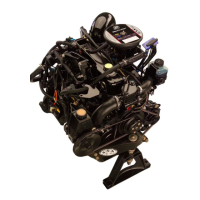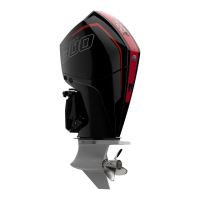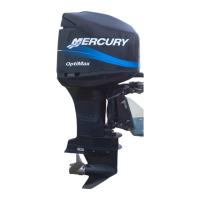90-826148R2 MARCH 19972A-12 - ELECTRICAL
Theory of Operation
The ignition system is alternator-driven with distri-
butor-less capacitor discharge. Major components of
the ignition system are the flywheel, stator, trigger,
timing protection module (TPM), capacitor discharge
modules (CDM) and spark plugs.
The stator assembly is mounted stationary below the
flywheel and has 2 (red stator has 3) capacitor charg-
ing coils wound in series. The flywheel is fitted with
6 permanent magnets inside the outer rim. As the fly-
wheel rotates the permanent magnets pass the ca-
pacitor charging coils causing the coils to produce
AC voltage (230 - 330 volts). The AC voltage then is
conducted to the capacitor discharge module (CDM)
where it is rectified and stored in a capacitor. Part of
the stator voltage (20 - 25 volts) is sent to the timing
protection module (TPM) to power the timing circuit.
The trigger assembly (also mounted under the fly-
wheel) has 1 coil. The flywheel has a another perma-
nent magnet located around the center hub. As the
flywheel rotates, this hub magnet passes the trigger
coil. This causes the trigger coil to produce a AC volt-
age pulse which is sent to the TPM. The TPM delays
this signal depending on engine RPM and forwards
a trigger signal to a electronic switch (SCR) within the
CDM.
The SCR switch discharges the stored voltage of the
capacitor into the primary side of the CDM’s ignition
coil.
Capacitor voltage within the CDM is amplified as high
as 45000 volts to jump the gap at the spark plug.
The preceding sequence occurs once-per-engine-
revolution for each cylinder.
Spark timing is changed (advanced/retarded) elec-
tronically by the TPM monitoring trigger pulses.
IMPORTANT: If the engine misfires, runs rough or
does not start, the ignition system should be
checked using a Multi-Meter/DVA Tester
(91-99750), or a voltmeter (capable of measuring
400 volts DC, or higher) and Direct Voltage Adap-
tor (91-89045).
Ignition Component
Description
Principle of Operation with Timing
Protection Module (TPM)
Under normal circumstances, the TPM controls:
1. Spark timing by monitoring the trigger pulses and
engine temperature.
2. Advances spark timing quickly to 25° BTDC un-
der hard acceleration conditions.
3. Provides over-speed protection if engine RPM
exceeds 5800. This occurs in 2 stages. Initially,
timing is retarded from 25° BTDC to 14° BTDC.
If RPM continues to increase above 6500, TPM
will shut ignition off momentarily until RPM drops
below 6500.
4. Provides an idle stabilizer function by advancing
timing when engine RPM drops below 600. At
crank speed of 300 RPM, timing can be as high
as 10° BTDC.
5. Provides warning control of OVER-HEAT and
LOW-OIL conditions. Warning is provided
through activation of a continuous tone warning
horn for either condition. An OVER-HEAT condi-
tion occurs when engine temperature rises
above 190° F ± 8° (88° C ± 13°). The TPM will
intermittently interrupt the ignition voltage to the
capacitor discharge modules (CDM) to reduce
maximum RPM to approximately 2500. The RPM
will be limited and the warning horn will activate
until engine temperature drops below 170° F ± 8°
(77° C ± 13°).
During a LOW-OIL condition, the TPM activates
the warning horn when switch in engine-mounted
oil tank is shorted to ground (closed). Engine
RPM is NOT limited during a LOW-OIL condition.

